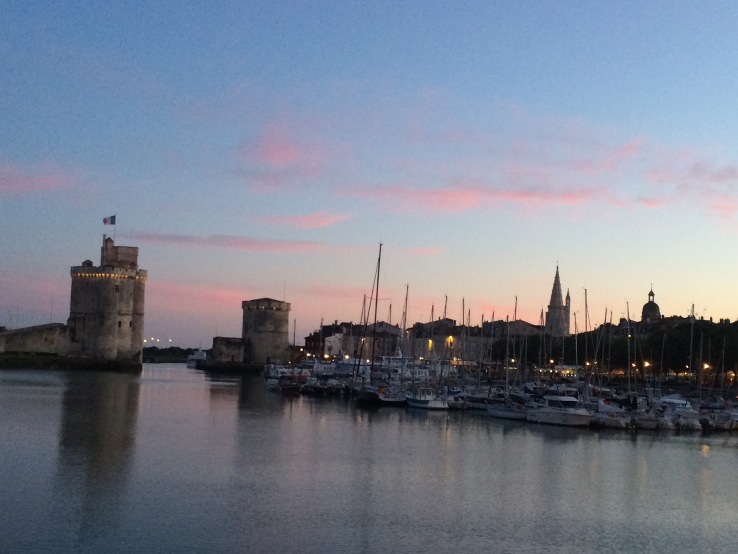 “En revenant de la jolie Rochelle”…the words of a song we had learned in school floated in the pale blue evening sky and drifted towards cotton-candy clouds.
“En revenant de la jolie Rochelle”…the words of a song we had learned in school floated in the pale blue evening sky and drifted towards cotton-candy clouds.
The 8th of June, 2016 had been another full day at La Rochelle. First thing in the morning we visited Les Archives Départementales de La Rochelle where we were shown historical documents from Acadian times.
Previously, on the drive from La Chaussée we had discussed the dueling historical perspectives on Charles de Saint-Étienne de la Tour and Charles de Menou d’Aulnay. We remarked that the French prefer d’Aulany’s heroics, especially in his home territory around La Chaussée.
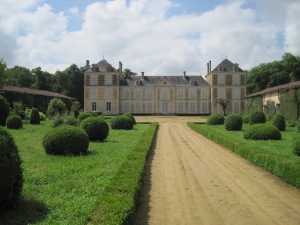
In Par en Bas, where I’m from and where most of us have a bit of La Tour blood in our veins, we lean towards the La Tour side of the story. Most people who have read anything on Acadian history know about their feud.
How amazing it was to see that the Archives had the original concessions given to Charles de la Tour when he was lieutenant général pour le roi en la côte de l’Acadie that is Lieutenant General for the King on the coast of Acadie. In the concession he recieved a) The fort and habitations on rivière Saint-Jean and b) Fort Saint-Louis in Cap de Sable. Date: 21 mars 1635, amirauté de La Rochelle. Impressive eh?
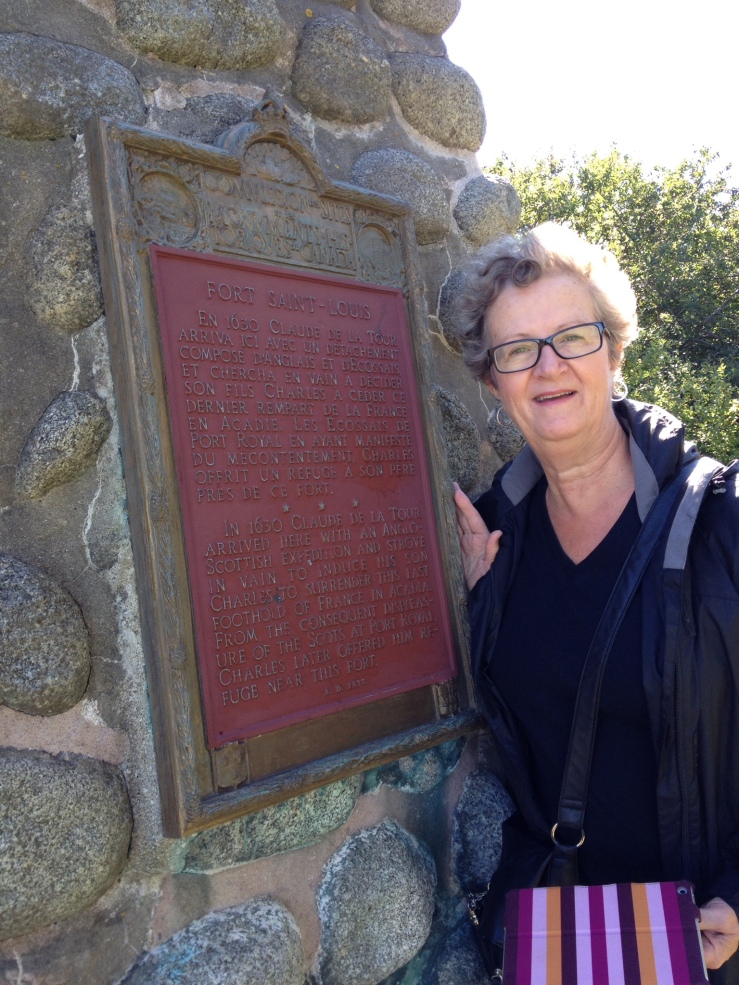
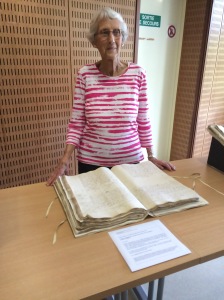 Master Ship Carpenter, Robert Cormier’s three-year contract for work at Fort Saint Pierre in Cape Breton told us he also took his wife and two children along. It seems they never came back to France. His son Thomas eventually married Marie-Madeleine Girouard, they had Anne and she married Michel Haché around 1690. They are the ancestors of all the Cormier in North America. What a thrill it was for Léona to touch this part of her history!
Master Ship Carpenter, Robert Cormier’s three-year contract for work at Fort Saint Pierre in Cape Breton told us he also took his wife and two children along. It seems they never came back to France. His son Thomas eventually married Marie-Madeleine Girouard, they had Anne and she married Michel Haché around 1690. They are the ancestors of all the Cormier in North America. What a thrill it was for Léona to touch this part of her history!
The main event of our visit was the parish register for Beaubassin’s Paroisse Notre-Dame-de-l’Assomption for the years 1712-1748. This old tattered ledger was saved by Acadians fleeing the deportations starting in 1755, first to St Pierre & Miquelon then La Rochelle in 1778. What a thrill to leaf through the document filled with Acadian family names: Bourg, Doucet, Daigle, Arsenaud, Chiasson, Godet, Richard.
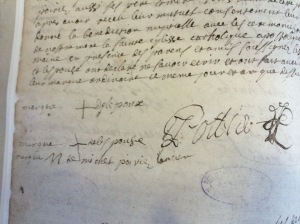
Personally, I was floored to find Jean Pottier’s name. My family tree is full of Pottier’s so it was especially interesting to see that he had signed his name, not the usual X. I had to laugh when I saw he had also made a sign (more like a squiggle) next to his name. It looked like a crown. In my family, it was an accepted truth that the Pottiers (no matter how they spell their names today) are smart and industrious. Chips off the old block? Must be! A few days earlier, I had noted that French locals used to pronounce Grandmère Rosalie’s maiden name “Po-ché” like us in Par en Bas!
The magnificent waterfront with it’s imposing Grosse Horloge Gate and moored sailboats, sitting on the mud of low tide, were our surroundings for lunch at an outdoor restaurant. Then it was a tour of La Rochelle, starting with a Musketeer who just appeared from around the time of he Siege of La Rochelle in 1627 to give us a historical account!
Supper was served by male waiters dressed in housedresses, the restaurant’s name Bistrot de Mémé, said it all.
After an entertaining and tasty supper a few of us set out in search of the beach. We had heard it was there but not found it yet and time was running out. Usually, the iconic harbour with it’s landmark towers the of Saint-Nicolas and la Chaîne had been as far as we had gone.
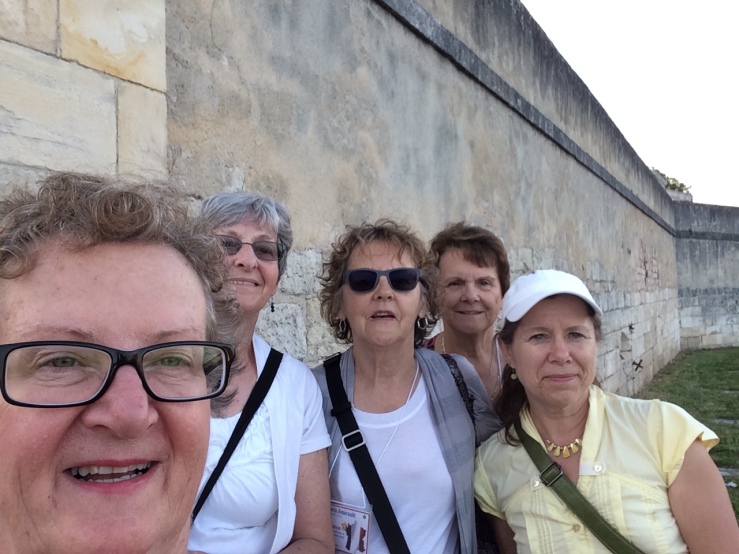
Anne, Annette, Gloria, Paula and I formed an informal search party. We followed cobblestone streets, narrow alleys and small bridges over rushing waters. When we reached it, the small beach gave a whole different feeling to the city. Hundreds of masts from neatly anchored sailboats bobbed in the marina on the horizon.
It really came home to us then. This water, this sea, this seaport was where our ancestors had sailed away from the lives they had known, headed for the New World-Acadie and uncertain futures. Now, almost ten generations later, we were back.
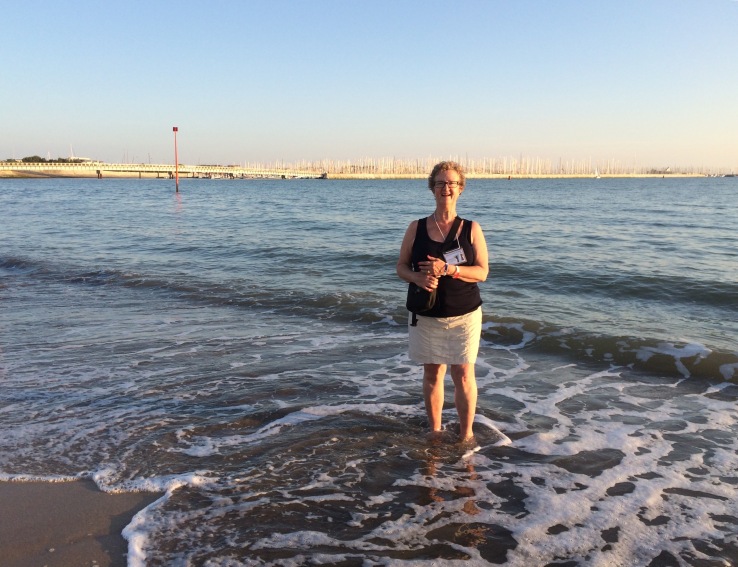
We took turns walking in the rippling surf; a kind of benediction, a spiritual connection with our past, a tangible sign.
From the beach we could see where parts of the walls still existed for this formerly walled city.
One by one, we climbed on the stone step built along the wall. We guessed it would take us to the Tour de la Lanterne. How appropriate that it would be a lighthouse leading Acadians home. The setting sun warmed its cream coloured stone walls and ornate spires in the distance.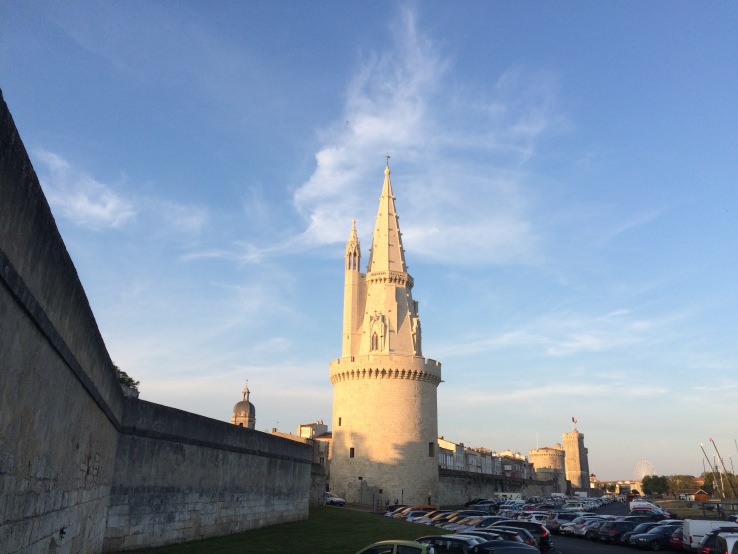
“En revenant de la jolie Rochelle” I don’t know who started singing it but soon we had all joined in. It was the perfect song for this night.
“J’ai rencontré trois jolies demoiselles.” We sang softly but clearly.
“C’est l’aviron qui nous mène, qui nous mène.” Ancient stone houses with terra cotta pots beside doors and flower-boxes filled with red geraniums witnessed our return.
“J’ai point choisi mais j’ai pris la plus belle.” Our footsteps crunched on the ancient stones and our fingers danced on the top of the gritty weathered stone wall.
“C’est l’aviron qui nous mène, c’est l’aviron qui nous mène en haut.”


